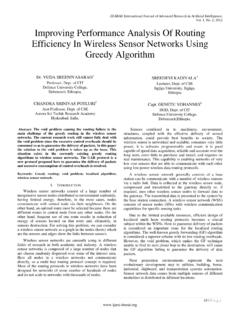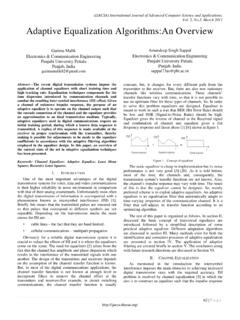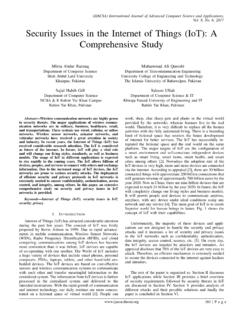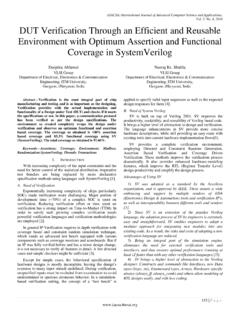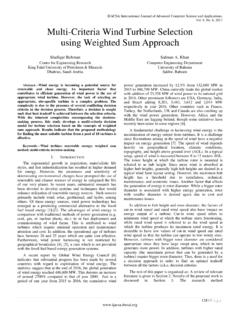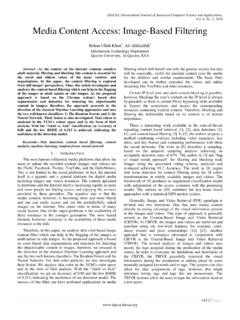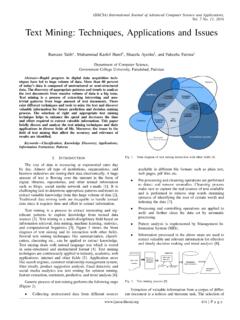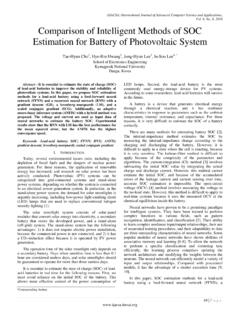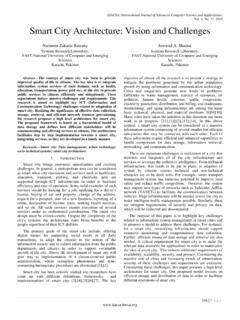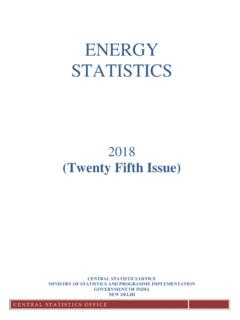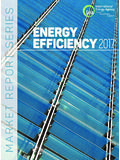Transcription of Vol. 8, No. 6, 2017 Impact of Distributed Generation …
1 (IJACSA) International Journal of Advanced Computer Science and Applications,Vol. 8, No. 6, 2017 Impact of Distributed Generation on the Reliabilityof Local Distribution SystemSanaullah AhmadElectrical Engineering DepartmentIQRA National University (INU)Peshawar,PakistanSana SardarElectrical Engineering DepartmentIQRA National University (INU)Peshawar,PakistanAzzam Ul AsarElectrical Engineering DepartmentCECOS UniversityPeshawar,PakistanBabar NoorElectrical Engineering DepartmentIQRA National University (INU)Peshawar,PakistanAbstract With the growth of Distributed Generation (DG)and renewable energy resources the power sector is becomingmore sophisticated, Distributed Generation technologies with itsdiverse impacts on power system is becoming attractive areafor researchers.
2 reliability is one of the vital area in electricpower system which defines continuous supply of power andcustomer satisfaction. Around the world many power generationand distribution companies conduct reliability tests to ensurecontinues supply of power to its customers. Uttermost reliabilityproblems in power system are due to distribution network. Inthis research reliability analysis of distribution system is interruption frequency and interruption duration increasesas the distance of load points increase from feeder. Injectionof single DG unit into distribution system increase reliability ofdistribution system, injecting multiple DG at different locationsand near to load points in distribution network further increasesreliability of distribution system, while introducing multiple DGat single location improves reliability of distribution reliability of distribution system remains unchanged whilevarying the size of DG unit.
3 Different reliability tests were doneto find the optimum location to plant DG in distribution these analyses distribution feeder bus 2 of RBTS is selected ascase study. The distribution feeder is modeled in ETAP, ETAP issoftware tool used for electrical power system modeling, analysis,design, optimization, operation, control, and automation. Theseresults can be helpful for power utilities and power producercompanies to conduct reliability tests and to properly utilizethe Distributed Generation sources for future expansion of Electric power system reliability ; Distributed gener-ation; reliability electricity demand is usually fulfilled by the powergenerated in electrical power plants.
4 Fig. 1 shows a traditionalpower plant with the transmission and distribution output power capacities depend upon size and type ofgeneration. These capacities typically range from hundreds ofMW to few GW [1] . Such large scale generating plants arelocated at a distance from load centers. Transmission linesand distribution feeders are used to transmit power from thepoint of Generation to the load points [2], [3]. The fundamentalcharacteristic of power system is to provide economical andFig. Power electricity to its customers. Presently, the operation ofpower system is considerably influenced by energy obtainedfrom renewable resources such as photovoltaic and windenergy system.
5 The major challenges that electrical utilitiesare going through is to provide power to the customers withlower rates and by increasing the market value of servicesthey provide with right amount of reliability and loweringthe maintenance cost, operational and constructional cost [4]. reliability is divided into system adequacy and security [5].The adequacy is associated to meet the customer demand inthe presence of sufficient electric power Generation . The termsecurity is associated to the capability of power system for itsresponse to instability and transients that occurs in the Generation is a new technique based on re-newable energy resources which will possibly participate as avital entity of electric Power System.
6 Distributed Generationcan also be considered as power Generation unit injected to dis-tribution network by neglecting the transmission lines, | P a g e(IJACSA) International Journal of Advanced Computer Science and Applications,Vol. 8, No. 6, 2017decreasing the technical losses [6], [7]. The power generatedfrom these DGs is not connected to the national grids as theyrange from few kilowatts (KW) to several megawatts (MW)[8], [9]. Radial distribution systems are much modest but aremore exposed to outages instead of interconnected normal operating conditions the loads accomplish itsrequired power demand, but if any fault occurs, the circuittrips causing failure to power flow.
7 Despite the fact thatdistribution systems have localized effects, statistics shows thatdistribution system failure affects the system as much as 85to 90 percent towards the unavailability of supply to load ascompared with failure of other parts of electric power system[10]. Amalgamation of DG in the distribution system willprovide an extra power for operation of loads even under faultyconditions. The placement of DG and protection devices willaffect the reliability of system with respect to DG penetration[11].Researchers are eager to develop such systems which arefeasible, economical and time saving to cope with the increas-ing power demand and improve power system reliability .
8 Inthis regard, Distributed Generation is considered to be the powerparadigm for the new millennium. Distributed Generation hasa vital Impact on power system, for this purpose, distributedgeneration source is connected to distribution system causingvariation in power flow and reliability factors. This dependson the optimal location, size and number of Distributed gen-eration. Power Generation and utility companies are lookingfor techniques to reduce costs and still provide the acceptablelevel of reliability necessary for the customers satisfaction. Onesolution is to add Distributed Generation with right configura-tions into distribution system. In this research the Impact ofdistributed Generation on the reliability of distribution systemwill be resources are categorized as non-renewable (con-ventional) and renewable (non conventional) energy based on renewable energy include PV modules,geo-thermal system and wind turbines.
9 Where as co-generationplants, fuel cells and heat engines are the technologies basedon non-conventional resources [12]. Fig. 2 shows differentconventional and non-conventional energy resources are in-tegrated with distribution system. In [13] a new plan ispresented to solve the network re-configuration problem inthe existence of Distributed Generation (DG) with an aim ofminimizing losses in real power and voltage profile improve-ment in distribution system. In the existing power systemthe generated power is transmitted to load centers throughlong transmission lines, causing technical losses. These lossescan be minimized by injecting the Distributed Generation nearto load centers, eliminating transmission losses and henceimproving the voltage profile.
10 Many benefits have been derivedfrom integration of DG units into the distribution networksby power system planners and policy makers [14]. Thesebenefits depend upon the characteristics of DG units such asphotovoltaic (PV), wind generating system and reciprocatingengines, type of loads, local renewable sources and networkpattern. This study comprehensively reviews various researchworks on the technical, environmental and economic benefitsof renewable DG integration such as reduction in line-loss, reliability enhancement, economic benefits and optimizing en-vironmental pollution. In [15], [16] the authors have discussedFig. System with Distributed maximum reliability improvement is obtained when theplacement of Distributed Generation is close to the customerpremises, making available maximum access in provisions ofcustomer numbers.
